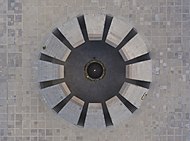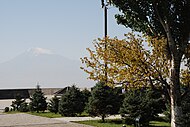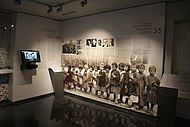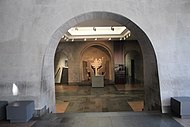Zizernakaberd
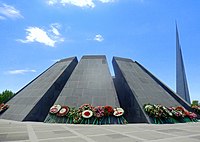 The memorial with obelisk (2017) |
|
| Data | |
|---|---|
| place |
Yerevan ( Kentron ), Armenia |
| Art |
Memorial and museum
|
| architect |
Memorial: Arthur Tarchanjan, Saschur Kalaschjan, Hovhannes Chatschatrjan; Museum: Saschur Kalaschjan, Lyudmila Mkrtschjan, Arthur Tarchanjan, F. Arakeljan |
| opening |
Memorial: November 29, 1967; Museum: 1995 |
| operator |
Armenian Genocide Museum-Institute Foundation (AGMI)
|
| management |
Harutjun Marutjan
|
| Website |
genocide-museum.am
(eng., arm., turk., russ., frz.) |

Zizernakaberd ( Armenian Ծիծեռնակաբերդ ; also English transcription Tsitsernakaberd widespread, western Armenian Dzidzernagapert ; translated as "Swallow Fortress ") is a monument complex in Yerevan to commemorate the victims of the Armenian genocide in 1915. It is located on the hill of the same name in the western part of the capital of Armenia . Every year on April 24, the genocide memorial day , gather at the monument Armenians to the victims to commemorate the genocide.
history
For half a century the genocide of the Armenians in 1915 was concealed by the Soviet authorities. It was not until the mass rallies by the population of Yerevan on the 50th anniversary of the genocide in 1965 that the authorities set up a memorial, without officially recognizing the genocide.
The hill Tsitsernakaberd, high above the Hrasdan River , with a view of the Ararat was chosen for the construction of the monument . In March 1965 an architecture competition was announced. Of the 78 projects, four were chosen as final. The project by the Armenian architects Saschur Kalaschjan and Arthur Tarchanjan and the artist Hovhannes Chatschatrjan won. The construction work lasted two years, from 1966 to 1968. In the 1990s, the underground museum and the memorial wall were built.
The monument complex
The monument complex consists of three elements: a 44-meter-high obelisk , which is split lengthways as a symbol of the division of the historical Armenian settlement area, twelve pylons around the eternal flame and a 100-meter-long wall with the names of the cities and villages in where the victims of the massacre lived.
In 1995, on the 80th anniversary of the genocide, the underground museum of the genocide of the Armenians was inaugurated. According to the design of architects Saschur Kalaschjan and Lyudmila Mkrtschjan, the building was built into the slope of the hill. In the museum there is a concert hall with 170 seats, which bears the name of the Armenian composer Komitas .
Trees were planted in the park avenue to commemorate the victims.
On the back of the memorial wall there are memorial plates for people who stood up for the victims during and after the genocide (including Johannes Lepsius , Franz Werfel , Armin Wegner , Henry Morgenthau , Fridtjof Nansen , Pope Benedict XV , Jakob Künzler , Bodil Biørn , Hedwig Büll ).
gallery
See also
Web links
Individual evidence
- ↑ http://www.genocide-museum.am/eng/Description_and_history.php (accessed May 3, 2020)
- ↑ http://www.genocide-museum.am/eng/aboutAGMI.php (accessed May 3, 2020)
- ↑ http://www.genocide-museum.am/eng/contacts.php (accessed May 3, 2020)
- ^ Adam T. Smith: "Yerevan, my ancient Erebuni": Archaeological repertoires, public assemblages, and the manufacture of a (post) Soviet Nation . In: Charles W. Hartley, G. Bike Yazicioğlu, Adam T. Smith (Eds.): The Archeology of Power and Politics in Eurasia: Regimes and Revolutions . Cambridge University Press , Cambridge 2012, ISBN 978-1-107-01652-1 , Chapter 3, pp. 73 ( limited preview in Google Book search).




